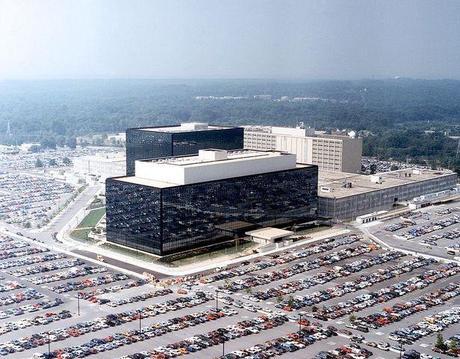
Headquarters of the NSA at Fort Meade, Md.
by Ingrid Burrington / Waging NonViolence
Mass surveillance has an image problem. The visual references commonly used to portray intelligence agencies — screens, servers and sleek glass buildings — don’t suggest an ethics or a rationale to their operations. They don’t suggest that there are even humans involved in collecting information about millions of other humans. In order to understand a world in which mass surveillance is increasingly deemed an unexceptional fact, it seems useful to face the apparatuses performing that surveillance in the most literal, prosaic way possible. For me, this meant driving to suburban Maryland.
In a small park next to the National Security Agency in Fort Meade, Md., signs explain rules about photographs one can take — and illustrate the kind of photo one isn’t allowed to take. Looking at the diagram of a restricted image reminded me of the ubiquitous stock photograph of the NSA, the one reminiscent of the Kaaba and among the few used by news outlets. The photograph’s ubiquity, along with its subject’s resemblance to another opaque monument, serves as shorthand for an institution that seeks to be perceived as beyond human comprehension or accountability.I made my pilgrimage not to the NSA, however, but to adjacent temples of lesser gods. The National Business Park is an office complex located less than a mile away from the NSA headquarters. Its tenants are mostly intelligence and defense contractors. According to the writer Tim Shorrock, contracting makes up about 70 percent of the defense intelligence budget. While the U.S. intelligence community has been subject to public scrutiny following Edward Snowden’s revelations about the surveillance state, the private contractors crucial to maintaining it — by designing software and hardware, providing analysis and building physical structures for government intelligence agencies — continue to do their work beneath the radar. As hope emerges that court rulings and panel recommendations might reform the NSA, it remains unlikely that these highly instrumental agents of intelligence gathering will be held accountable for their role in crafting the surveillance state. It also remains unclear where private intelligence contractors might shift their focus if they lose their top client (though their other clients currently include city police departments, international governments and private corporations).
The landscape of the National Business Park offers little insight into the vast, byzantine protocols of the surveillance state. But plausible deniability is itself an architectural choice, one made manifest not only in procurements and mergers, not only in networks and protocols, but also in drywall and concrete and stock photography.

